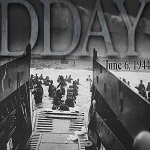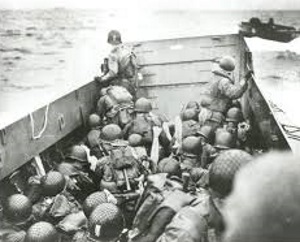Dubliners in D-Day
Published on 16th September 2019
 It is impossible to say with any degree of certainty how many Irish took part in Operation Overlord, the Allied invasion of Normandy on 6 June, 1944. A precise figure for Irish enlistments in the British forces for the war as a whole is not available and estimates vary between 70–120,000 men and women. Given the large Irish population in North America, we can be sure that Irish were also present in the Canadian forces who landed at Juno beach, as well as the American 1st and 4th Divisions which came ashore at Omaha and Utah, but trying to put a figure on Irish involvement, either in the invasion fleet, in the air above or storming the beaches themselves, would be purely speculation.
It is impossible to say with any degree of certainty how many Irish took part in Operation Overlord, the Allied invasion of Normandy on 6 June, 1944. A precise figure for Irish enlistments in the British forces for the war as a whole is not available and estimates vary between 70–120,000 men and women. Given the large Irish population in North America, we can be sure that Irish were also present in the Canadian forces who landed at Juno beach, as well as the American 1st and 4th Divisions which came ashore at Omaha and Utah, but trying to put a figure on Irish involvement, either in the invasion fleet, in the air above or storming the beaches themselves, would be purely speculation.
Irish regiments and formations played leading roles in the Allied attack on Normandy and were well represented in the 21st Army Group, which comprised of the Canadian First and British Second armies. The 4th/7th Royal Dragoon Guards (which contained the old 4th Royal Irish Dragoon Guards) was part of the 8th Armoured Brigade; the 2nd (Armoured) Battalion of the Irish Guards formed an element of the 5th Guards Armoured Brigade; the 5th Royal Inniskilling Dragoon Guards and the 8th Kings Royal Irish Hussars were part of the 22nd Armoured Brigade; the 1st Battalion of the Royal Ulster Rifles was part of the 6th Airborne Division, while the 2nd Battalion was in the 3rd Infantry Division.
The Royal Ulster Rifles was amongst the first Allied troops to touch down in France. The 1st Battalion landed by glider to the east of Sword beach and were preceded by the 591 (Antrim) Parachute Squadron Royal Engineers, who were tasked with clearing landing sites for the incoming gliders. 2nd Battalion Royal Ulster Rifles was amongst those who landed on Sword beach itself.
 Into the Jaws of Death, opposite, one of the most reproduced photographs to come out of D-Day. Albert Sutton, a Dubliner who joined the RAF, landed in Normandy shortly after the invasion and was surprised to find himself there as his officers had not informed the unit what their destination was. Although the beaches were largely clear by the time he arrived, danger still lurked for the unwary. The main threat to Albert and his comrades upon disembarking from the landing craft were uncleared mines and the beach was plastered with ‘Achtung Minen’ signs, all accompanied with a depiction of skull and crossbones.
Into the Jaws of Death, opposite, one of the most reproduced photographs to come out of D-Day. Albert Sutton, a Dubliner who joined the RAF, landed in Normandy shortly after the invasion and was surprised to find himself there as his officers had not informed the unit what their destination was. Although the beaches were largely clear by the time he arrived, danger still lurked for the unwary. The main threat to Albert and his comrades upon disembarking from the landing craft were uncleared mines and the beach was plastered with ‘Achtung Minen’ signs, all accompanied with a depiction of skull and crossbones.
One thing that always stuck in Albert’s mind was that he was warned not to stop to help any wounded comrades, as that would present a stationary target to any lingering Germans. As a Leading Aircraftsman (LAC), Albert’s role was to prepare temporary landing sites for British and Canadian air fighters and fighter-bombers, as well as repairing, refueling and rearming them while they were waiting. Having fought his way through France, Belgium and Holland, Albert ended up in Denmark in 1945; in 2017 he was made a Chevalier of the Order of the Legion d’Honneur, the highest French military decoration and belatedly received recognition of the role he played in the liberation of France.
Blogpost by: Bernard Kelly, Historian in Residence, Dublin City Library and Archive.